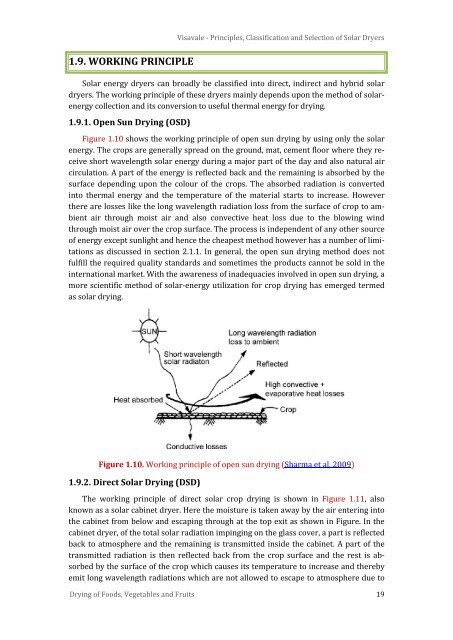Solar Drying: Fundamentals,Applications and Innovations - National ...
Solar Drying: Fundamentals,Applications and Innovations - National ...
Solar Drying: Fundamentals,Applications and Innovations - National ...
Create successful ePaper yourself
Turn your PDF publications into a flip-book with our unique Google optimized e-Paper software.
1.9. WORKING PRINCIPLE<br />
Visavale - Principles, Classification <strong>and</strong> Selection of <strong>Solar</strong> Dryers<br />
<strong>Solar</strong> energy dryers can broadly be classified into direct, indirect <strong>and</strong> hybrid solar<br />
dryers. The working principle of these dryers mainly depends upon the method of solarenergy<br />
collection <strong>and</strong> its conversion to useful thermal energy for drying.<br />
1.9.1. Open Sun <strong>Drying</strong> (OSD)<br />
Figure 1.10 shows the working principle of open sun drying by using only the solar<br />
energy. The crops are generally spread on the ground, mat, cement floor where they receive<br />
short wavelength solar energy during a major part of the day <strong>and</strong> also natural air<br />
circulation. A part of the energy is reflected back <strong>and</strong> the remaining is absorbed by the<br />
surface depending upon the colour of the crops. The absorbed radiation is converted<br />
into thermal energy <strong>and</strong> the temperature of the material starts to increase. However<br />
there are losses like the long wavelength radiation loss from the surface of crop to ambient<br />
air through moist air <strong>and</strong> also convective heat loss due to the blowing wind<br />
through moist air over the crop surface. The process is independent of any other source<br />
of energy except sunlight <strong>and</strong> hence the cheapest method however has a number of limitations<br />
as discussed in section 2.1.1. In general, the open sun drying method does not<br />
fulfill the required quality st<strong>and</strong>ards <strong>and</strong> sometimes the products cannot be sold in the<br />
international market. With the awareness of inadequacies involved in open sun drying, a<br />
more scientific method of solar-energy utilization for crop drying has emerged termed<br />
as solar drying.<br />
Figure 1.10. Working principle of open sun drying (Sharma et al. 2009)<br />
1.9.2. Direct <strong>Solar</strong> <strong>Drying</strong> (DSD)<br />
The working principle of direct solar crop drying is shown in Figure 1.11, also<br />
known as a solar cabinet dryer. Here the moisture is taken away by the air entering into<br />
the cabinet from below <strong>and</strong> escaping through at the top exit as shown in Figure. In the<br />
cabinet dryer, of the total solar radiation impinging on the glass cover, a part is reflected<br />
back to atmosphere <strong>and</strong> the remaining is transmitted inside the cabinet. A part of the<br />
transmitted radiation is then reflected back from the crop surface <strong>and</strong> the rest is absorbed<br />
by the surface of the crop which causes its temperature to increase <strong>and</strong> thereby<br />
emit long wavelength radiations which are not allowed to escape to atmosphere due to<br />
<strong>Drying</strong> of Foods, Vegetables <strong>and</strong> Fruits 19

















